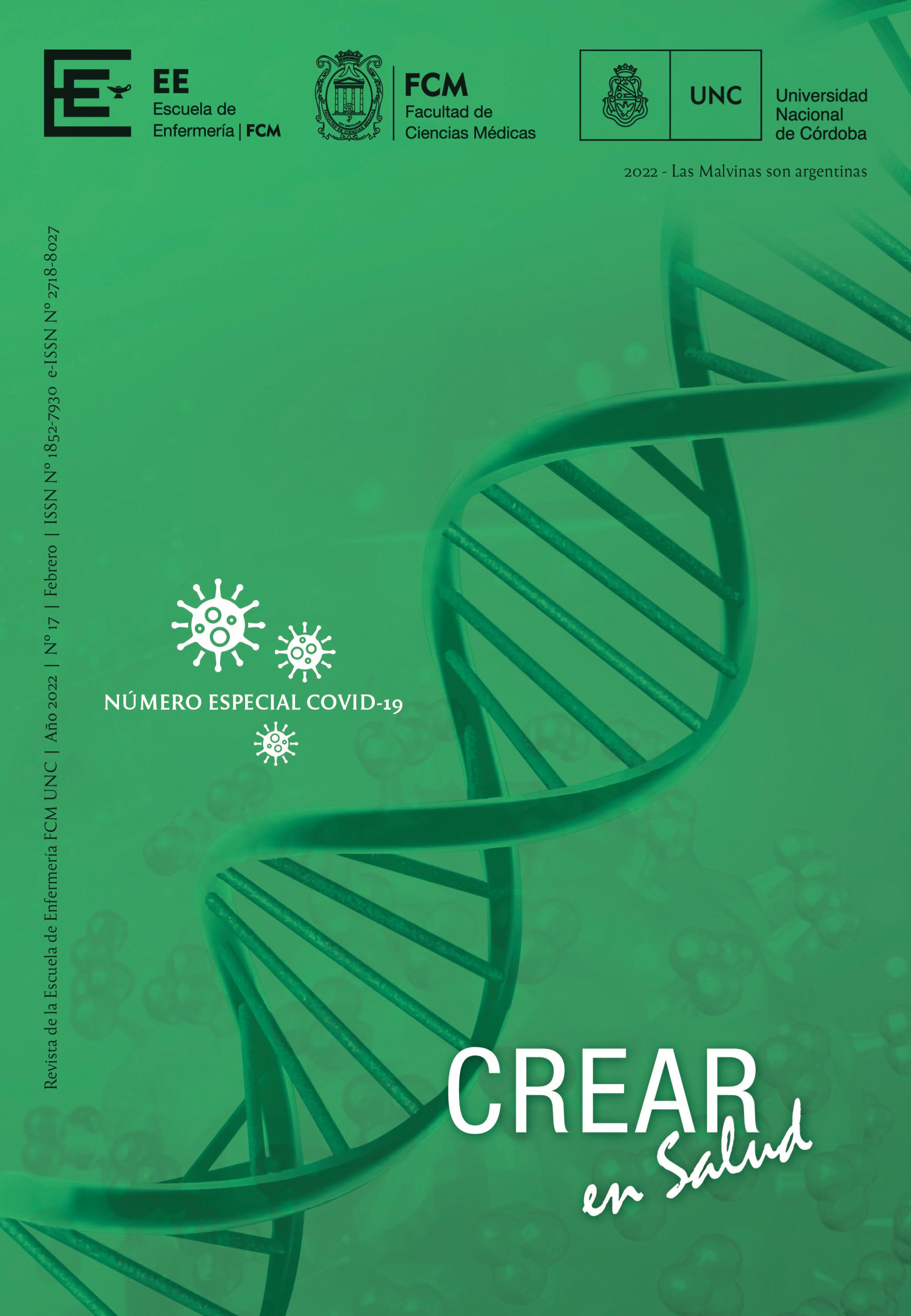Self-care practices of adolescents in the frameworkof the Covid-19 pandemic
Keywords:
Adolescence – Behaviors – Self-care practices – Health – Covid-19 – VirtualityAbstract
ABSTRACT
Introduction: The World Health Organization (WHO, 2020) defines adolescence as a life stage
during which subjects define their personalities, behaviors, identities and roles. This study
sought to establish the self-care practices of adolescents of a secondary school in the framework
of the COVID-19 pandemic and their ways of adapting to the preventive measures that affected
teaching practices, the students’ learning and the pursuit of programmatic and institutional
goals. Besides, inquiries were made into the self-care practices in its different dimensions such
as physical, social and psychological. Methodology: It was a descriptive, cross-sectional study
carried out with Education Rural Center students in the Department of Santa María in the
province of Córdoba during the first semester of the year 2021. An online survey was used.
Results and Conclusion: The information obtained showed that, in general, adolescents in
the framework of the COVID-19 pandemic practice self-care and have healthy habits. Physical
activity decreased since 59.1 % of adolescents do not practice it; water consumption displays
65.9 % of adolescents who drink water at times. Eating patterns were altered, especially
breakfast, since only 50 % of adolescents have breakfast, 80 % of them sleep 8 hours, and 63.6
% of them drink alcohol. Regarding STDs and pregnancy preventive measures, adolescentes
are seen to positively take preventive measures and sexual care practices. Regarding the social
dimension, 54.5 % display a good relationship with their parents and 52.3 % of them show a
good relationship with their peers. Regarding the psychological dimension, 77.3 % always
stand up for their own decisions when interacting with friends and 34.1 % of them accept
consequences and orders. Discussion: Important points were recognized to be reflected on
and some other points that must be reinforced through intervention. According to Álvarez
(2011), quoted by Naranjo (2017), these activities are performed by individuals, families and/or
communities with the purpose of promoting health, preventing diseases or limiting an ongoing
disease, and of reestablishing health when it is
necessary.
References
REFERENCIAS BIBLIOGRÁFICAS
Álvarez, L. (2011). Los estilos de vida en salud: del individuo al contexto. Revista Fac. Nac. Salud Pública, 30(1), 95-101. http://www.scielo.org.co/pdf/rfnsp/v30n1/v30n1a11.pdf
Barreto, M. L. (2017). Desigualdades en Salud: una perspectiva global. Revista Ciencia y Salud colectiva, 22(7), 2097-2108. https://www.scielo.br/j/csc/a/XLS4hCMT6k5nMQy8BJzJhHx/?format=pdf &lang=es
Gómez Arias (2018). ¿Que se ha entendido por salud enfermedad? Revista Facultad Nacional de salud pública, 36(1), 64-102. https://revistas.udea.edu.co/index.php/fnsp/article/view/335873/20791472
Güemes Hidalgo, M., Ceñal Gonzalez Fierro, M. J. e Hidalgo Vicario, M. I. (2017). Desarrollo durante la adolescencia. Aspectos físicos, psicológicos y sociales. Revista Pediatría Integral, XXI(4), 233-244. https://www.adolescenciasema.org/ficheros/PEDIATRIA%20INTEGRAL/Desarrollo%20durante%20la%20Adolescencia.pdf
Le Breton, D. (2003). Adolescencia bajo riesgo. Cuerpo a cuerpo con el mundo. Montevideo: Trilce. https://isbn.cloud/9789974323254/adolescencia-bajo-riesgo/
Naranjo Hernández, Y., José Alejandro Concepción Pacheco, J. A., y Rodríguez Larreynaga, M. (2017). La teoría Déficit de autocuidado: Dorothea Elizabeth Orem. Revista Gaceta Medica Espirituana, 19(3). http://scielo.sld.cu/pdf/gme/v19n3/GME09317.pdf
Observatorio de adolescentes y jóvenes (2020). Jóvenes migrantes y jóvenes de Barrios populares en Pandemia. Del tempo detenido a las nuevas fronteras. http://observatoriojovenesiigg.sociales.uba.ar/wp-content/uploads/sites/113/2020/09/OAJ-juventudes-migrantes-y-de-barrios-en-pandemia-2020.pdf
Olarte, M. R. (2018). La salud como patrimonio público. Revista Biosalud,18(1), 65-81. https://revistasojs.ucaldas.edu.co/index.php/biosalud/article/view/3660/3377
Organización Mundial de la Salud. (2020). Salud del adolescente. https://www.paho.org/es/temas/salud-adolescente
Organización Mundial de la Salud. (2011). Informe sobre la situación mundial de las enfermedades no transmisibles 2010. http://www.who.int/nmh/publications/ncd_report_summary_es.pdf?ua=1
Organización mundial de la salud (2008). Medidas efectivas para el control de tabaco. https://www3.paho.org/hq/index.php?option=com_content&view=article& id=1350:medidas-efectivas-control-tabaco&Itemid=1185&lang=es
Prado Solar, L. (2014). La teoría Déficit de autocuidado: Dorothea Orem punto de partida para calidad en la atención.
http://scielo.sld.cu/pdf/rme/v36n6/rme040614.pdf
Presidencia de la Nación Argentina. Secretaría de Programación para la Prevención de la Drogadicción y la Lucha contra el Narcotráfico. (SEDRONAR). (2014). Sexto estudio Nacional sobre el consumo de sustancias psicoactivas en estudiantes de enseñanza media. https://www.argentina.gob.ar/sites/default/files/2020/10/oad_2014._sexto_estudio_sobre_consumo_de_sustancias_psicoactivas_en_estudiantes_de_ensenanza_media_diagnostico_nivel_pais.pdf
Ramos Paul, R. (2019). Tratamiento Psicológico para adolescentes rebeldes. https://rocioramos paul.com/terapia/adolescentes-rebeldes-agresivos/
Ramos Valverde, P. (2009). Estilos de vida y salud en la adolescencia. [Tesis Doctoral. Universidad de Sevilla]. https://idus.us.es/bitstream/handle/11441/15476/Y_TD_PS-PROV9. pdf?sequence=1&isAllowed=y
Sacchi, M., Hausberger, M., y Pereyra, A. (2007). Percepción del proceso salud-enfermedad- atención y aspectos que influyen en la baja utilización del Sistema de Salud, en familias pobres de la ciudad de Salta. Revista Salud colectiva, 3(3), 271-283. http://www.scielo.org.ar/pdf/sc/v3n3/v3n3a05.pdf
Universidad Nacional de Educación. Enrique Guzmán y Valle. Dirección de Bienestar universitario. Unidad de Deportes y Recreación (2020). La Actividad Física en tiempos de Pandemia (Covid19). Programa de Ejercicios.
Vélez Álvarez, C. y Bentancurth Loaiza, D. P. (2015). Estilos de vida en adolescentes escolarizados en un municipio colombiano. Revista Cubana de Pediatría, 87(4). http://www.revpediatria.sld.cu/index.php/ped/article/view/7/6
Downloads
Published
Issue
Section
License

This work is licensed under a Creative Commons Attribution-NonCommercial 4.0 International License.



